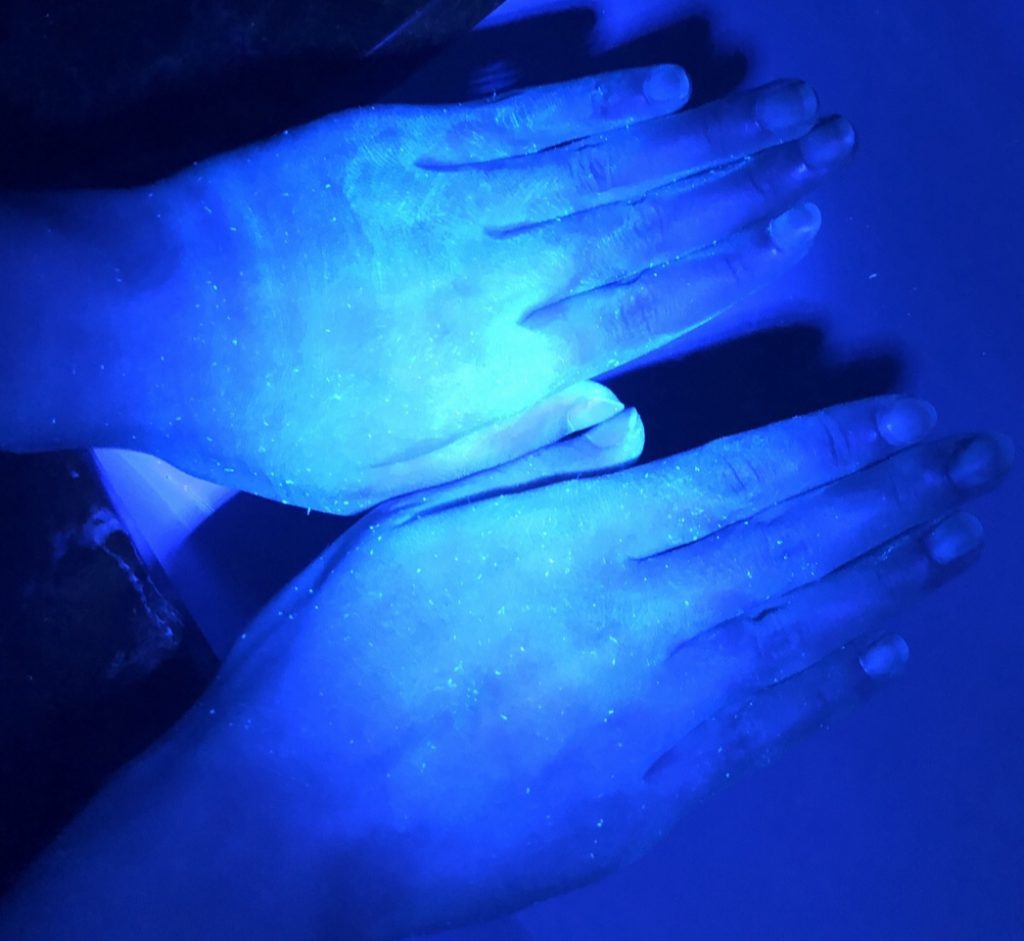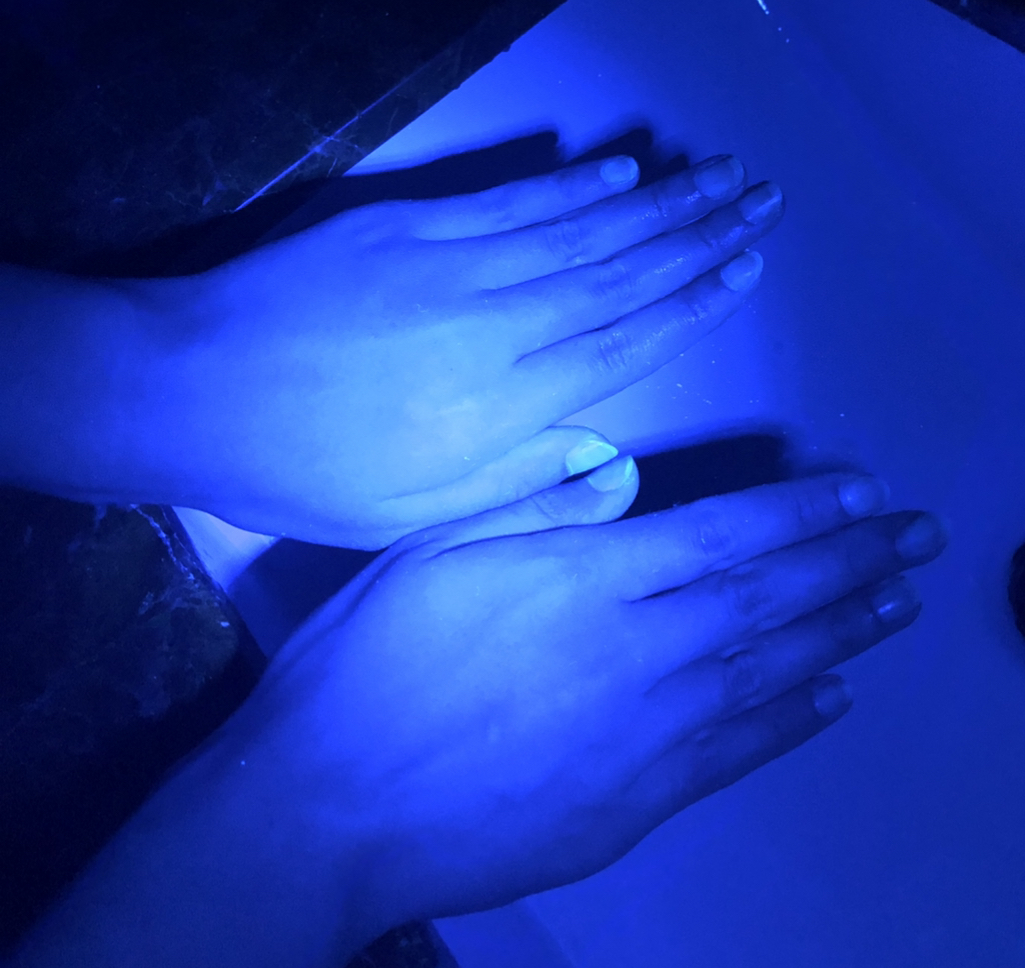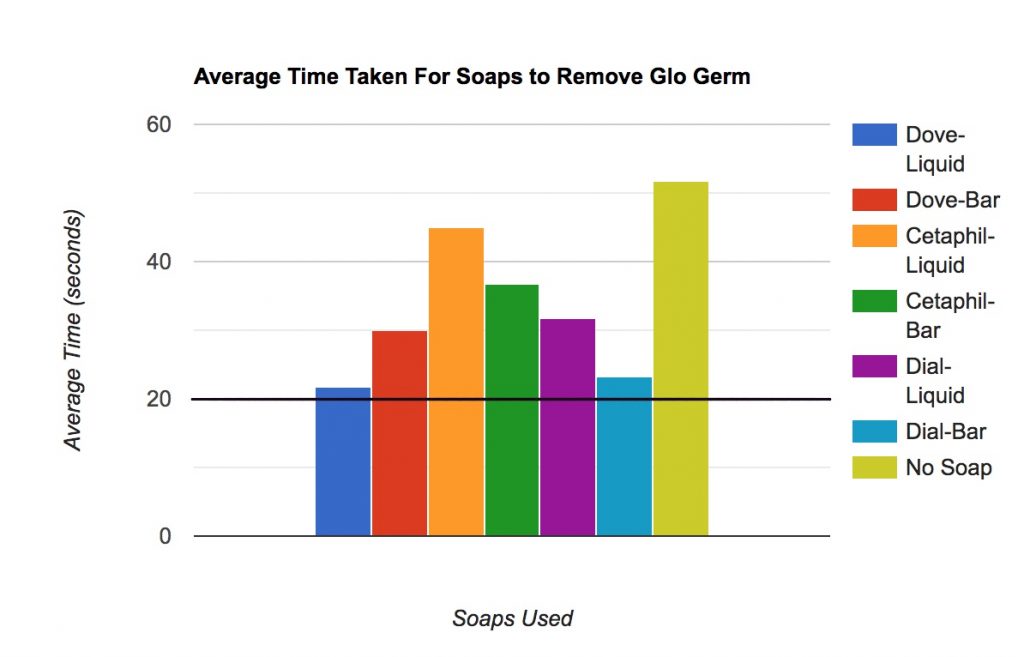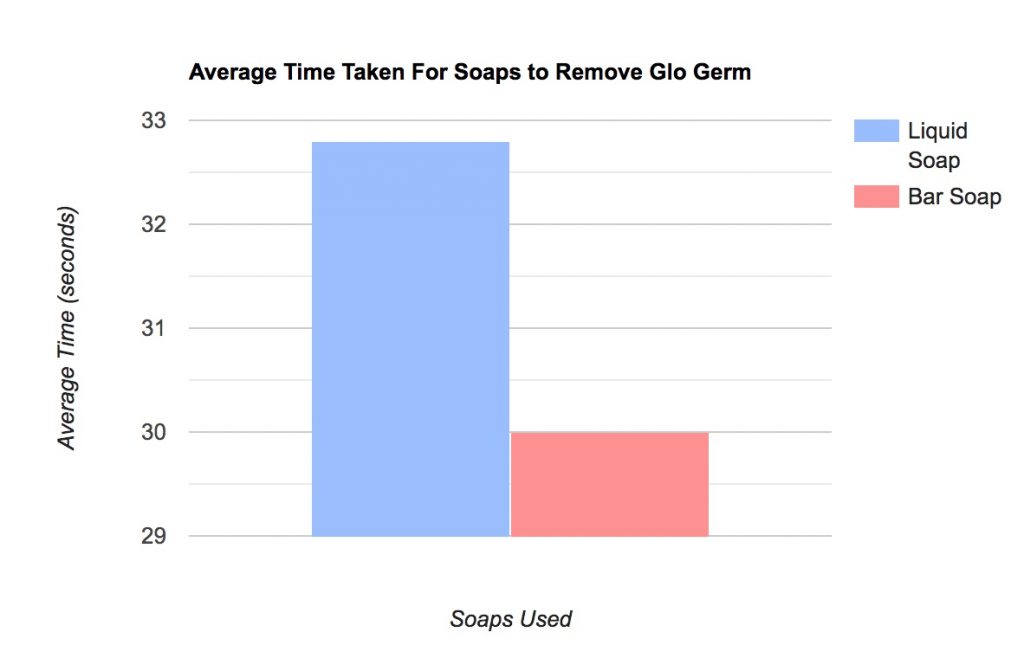Angela Qian, Year 2 Research.
Abstract
During the COVID-19 pandemic, hand washing has become ever more important. With so many options for potential hand soaps, it is logical to question which soap, if any, is most effective at achieving its goal of cleaning the surfaces of hands. This study tested two soaps from three
popular brands, with six soaps in total. Moreover, the two soaps were split into liquid soaps, and bar soaps. Each soap was used to wash Glo Germ lotion from the hands. The amount of time each soap required to completely eliminate the lotion was recorded and compared. Overall, two
of the three brands performed roughly the same, with the third brand performing slightly worse. Additionally, bar soaps performed slightly better than liquid soaps. The results from this experiment calls into question the necessity of having such an oversaturated market for the product. Additionally, future research should be conducted, testing the efficacy of soaps that contain antimicrobial substances against soaps that do not
Introduction
Hand washing is the basis to good personal hygiene, especially during the Covid-19 pandemic (Jabr, 2020); however, with such a large market for hand soaps, it can be difficult for consumers to decide which brand and type of soap they should use (Grand View, 2019). With over 300 000 soap making businesses in the United States alone, the choices really do seem endless (Decker, 2019). Certain soaps claim to be antibacterial, while others claim to be gentle on the skin; however, no matter the brand or type, all soaps eliminate microbes in a similar manner (Jabr, 2020). Soap molecules are composed of two ends: a water-loving, hydrophilic head, and a water-hating hydrophobic tail (Jabr, 2020). Some bacteria and viruses have lipid membranes, which the hydrophobic tails of soap molecules can attach to and pry open, killing the microbe (Jabr, 2020). Currently, soaps contain more chemicals meant to make them more effective; however, some of these ingredients may cause skin irritation and promote bacterial resistance (Kampf and Kramer, 2004). Two specific ingredients that have the potential to cause bacterial resistance are triclosan, and chlorhexidine, with chlorhexidine having a slightly higher risk than triclosan (Kampf and
Kramer, 2004). Furthermore, solutions prepared with 4% chlorhexidine may cause a higher rate of irritant dermatitis compared with non-antimicrobial soaps and alcohol-based hand rubs (Kampf and Kramer, 2004). On the other hand, triclosan may stimulate the transfer of resistance genes within bacterial populations, thus increasing the possibility of bacterial resistance to the substance (Lu et al. 2018). When used properly and effectively, soap can help protect not just the individual, but also those around them (Jabr, 2020). With all these complicating details, this project sets out to determine the efficacy of different brands and types of soaps at removing pathogens from the surface of the hands, in order to determine which soap is most ideal for use in a home environment.
Materials and Methods
Three popular soap brands were selected for this project: Dial, Dove, and Cetaphil, with both a bar soap and liquid soap per brand. Thus, a total of six soaps were used for this experiment in an attempt to cover a wide range of possibilities. The Dove and Dial liquid soaps were dispensed as foam, while the Cetaphil liquid soap was dispensed as a liquid. Dial specifically claimed to be antibacterial, while Cetaphil claimed to be gentle on skin. Glo Germ lotion (Marlatek) was used to replicate pathogens that may be present on the hands, and a UV flashlight was used to observe the amount of Glo Germ lotion present on the hands after hand washing.
A small amount of Glo Germ lotion was applied evenly to the hands and wrist. The hands were then observed under UV light to ensure proper coating of the lotion, as shown in Figure 1. A constant amount of the soap being tested was then applied to wet hands–one pump for the liquid
soaps, and three rubs for the bar soaps. The hands were then washed with the same technique and order: palm, back of hands, fingers, thumbs, and finally fingertips. The temperature of the water was kept constant for each soap type tested. The time taken for each brand to completely clean
the hands of Glo Germ lotion was recorded in intervals of 5 seconds. The hands were observed under UV light after each 5 second interval until no Glo Germ lotion remained, as shown in Figure 2. Each soap type was tested 3 times, and their averages were calculated and graphed in Figure 3. For the control variable, the hands were rinsed with water and no soap was used.

Figure 1: Hand covered in Glo-germ gel under a UV light before the handwashing process

Figure 2: Hand under UV light after the handwashing process, all Glo-germ gel has been removed
Results
Overall, there was a noticeable difference between the types and brands of soaps. Of the total 6 soaps, Dove’s liquid soap performed the best with an average time of 21.7 seconds, followed by Dial’s bar soap with an average time of 23.3 seconds. Dove’s bar soap took an average of 30 seconds, while Dial’s liquid soap took roughly 31.7 seconds. Both of Cetaphil’s soaps took the longest time to clean the hands from the lotion. Cetaphil’s bar soap took 36.7 seconds, and its liquid soap took 45 seconds. Additionally, the bar soaps overall took less time than the liquid soaps, with an average time of 30 seconds, while the liquid soaps had an average of 32.8 seconds, as shown in Figure 4. All 6 soaps performed better than the control, which took on
average roughly 51.7 seconds to completely remove the Glo Germ lotion from the hands. Of the 6 soaps, Dove’s liquid soap and Dial’s bar soap were able to come close to the recommended 20 seconds of hand washing necessary to effectively clean hands–represented by the black line in
Figure 3 (CDC, 2020). The other 4 soaps took at least 30 seconds to wash off the Glo Germ lotion, according to Figure 3.

Figure 3: Graph and average time taken for each soap to remove Glo-germ gel from hands. The black line at 20 seconds represents the CDC recommended time for effective hand washing.

Figure 4: Graph of the average time taken for liquid and bar soaps to remove Glo-germ gel from hands.
Discussion
From the three brands, Dove’s soaps required on average the shortest time to remove the Glo Germ lotion. Dial took slightly longer, and Cetaphil took the longest time on average. Overall, bar soaps performed faster than liquid soaps. This could be due to that fact that bar soaps came in physical contact with the skin, removing some of the lotion through touch. Whether or not this phenomenon is true for actual microbes will require further testing. In the case of the ranking of the three brands, Dove and Dial took roughly the same amount of time to effectively clean the hands, while Cetaphil took slightly longer. This may be because Cetaphil is a soap-free cleanser.
While the lack of soap may reduce the possibility of skin irritation, it could potentially affect Cetaphil’s ability to remove microbes from the surface of the skin. Cetaphil does contain cetearyl alcohol, which acts as an emulsifier (Von der Ohe and Aalizadeh 2020); however, its efficacy ascompared with soap is unclear and will require further testing.
It’s worth noting that Dial, which claimed to be antibacterial, was no more effective than Dove’s regular soap. Of course, this could be affected by the use of Glo Germ lotion. While the lotion provides a simulation of pathogens, it does not contain any actual microbes. Thus, it is possible that the lotion may behave slightly differently than actual pathogens. Additionally, the lotion was easily rubbed off of the hands, which may have made it easier to remove. The lack of standardized testing methods for the efficacy of soaps in general was another detriment, as this study had little reference to use when designing the experimental procedure (Foddai, Grand and Dean 2016). The amount of soap that should be used per trial, temperature of the water, and the hand washing techniques used in this experiment were chosen to replicate an everyday hand washing experience; however, due to the lack of standardization, it is uncertain if the amount of
soap, water temperature, and techniques used were the most effective at cleaning the hands. Determining a standardized way of testing soaps will likely require an experiment in its own right.
Overall, the results from this experiment shows that two of the three tested soaps were fairly similar in terms of efficiency. Thus, this brings into question whether the hand soap industry needs to be so saturated. Additionally, the availability of antibacterial soaps brings risk of bacterial resistance. As shown in the experiment, Dial’s antibacterial soaps performed no better than Dove’s regular hand soaps. Due to this, it may be advantageous for consumers to avoid unnecessary use of antibacterial soaps. It is worthy to note that none of the soaps used in this experiment contained triclosan or chlorhexidine. Whether or not these two specific chemicals increases a soap’s efficacy will require further testing.
References
Boyce, John M., et al. “Skin Irritation and Dryness Associated With Two Hand-Hygiene Regimens: Soap-and-Water Hand Washing Versus Hand Antisepsis With an Alcoholic Hand Gel: Infection Control & Hospital Epidemiology.” Cambridge Core, Cambridge University
Press, 2 Jan. 2015, www.cambridge.org/core/journals/infection-control-and-hospital-epidemiology/article/abs/skin-irritation-and-dryness-associated-with-two-handhygiene-regimens-soapandwater-hand-was
hing-versus-hand-antisepsis-with-an-alcoholic-hand gel/8A6A9D309C73894EDF7D8E06EE095B64.
“When and How to Wash Your Hands.” Centers for Disease Control and Prevention, Centers for Disease Control and Prevention, 24 Nov. 2020,
www.cdc.gov/handwashing/when-how-handwashing.html.
Decker, Ivy. Today’s Soapmakers: Demographics and Statistics, 2019,
blog.anthonythomas.com/todays-soapmakers-demographics-and-statistics#:~:text=According%20to%20the%20Handcrafted%20Soap,%2C%20design%2C%20and%20other%20factors
M;, Foddai AC; Grant IR; Dean. “Efficacy of Instant Hand Sanitizers against Foodborne Pathogens Compared with Hand Washing with Soap and Water in Food Preparation Settings: A Systematic Review.” Journal of Food Protection, U.S. National Library of Medicine, 2016,
pubmed.ncbi.nlm.nih.gov/27296611/.
“Liquid Soap Market Size, Share: Global Industry Report, 2019-2025.” Liquid Soap Market Size,Share | Global Industry Report, 2019-2025, Grand View Research, 2019, www.grandviewresearch.com/industry-analysis/liquid-soap-market#:~:text=Industry%20Insights,driving%20factor%20for%20the%20market.
Jabr, Ferris. “Why Soap Works.” The New York Times, The New York Times, 13 Mar. 2020, www.nytimes.com/2020/03/13/health/soap-coronavirus-handwashing-germs.html.
A;, Kampf G;Kramer. “Epidemiologic Background of Hand Hygiene and Evaluation of the Most Important Agents for Scrubs and Rubs.” Clinical Microbiology Reviews, U.S. National Library of Medicine, 2004, pubmed.ncbi.nlm.nih.gov/15489352/.
Lu J, et al. “Triclosan at Environmentally Relevant Concentrations Promotes Horizontal Transfer of Multidrug Resistance Genes within and across Bacterial Genera.” Environment International, U.S. National Library of Medicine, 2018, pubmed.ncbi.nlm.nih.gov/30389380/.
Meijer, Jeroen, et al. “An Annotation Database for Chemicals of Emerging Concern in Exposome Research.” Environment International, Pergamon, 24 Mar. 2021,
www.sciencedirect.com/science/article/pii/S0160412021001367.